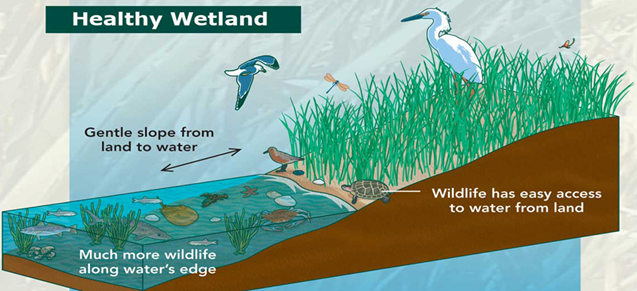by Dr. Lenore Tedesco, Executive Director
Healthy marsh edges are sloped from the flat marsh plain down to the mud flat apron of the tidal channels. Shorter marsh grasses give way to taller grasses that are flooded more frequently by the tides. These edges teem with life.
 Many marsh edges however, are highly erosional with vertical scarps and ledges, and blocks that drop into the adjacent channels. Some of this is caused by storms – predominantly to the north and west facing margins of the marsh. Unfortunately, much more is the product of boat wakes damaging the marsh edge. In some places of focused boat wakes, marshes are eroding back several feet per year.
Many marsh edges however, are highly erosional with vertical scarps and ledges, and blocks that drop into the adjacent channels. Some of this is caused by storms – predominantly to the north and west facing margins of the marsh. Unfortunately, much more is the product of boat wakes damaging the marsh edge. In some places of focused boat wakes, marshes are eroding back several feet per year.
 How can you help? Avoid high-speed boating, tubing, and wakeboarding in narrow tidal channels where boat wakes do the most damage. Reserve the narrow marsh-bordered tidal channels for paddleboards and kayaks. You can also join us as a volunteer in a new program to help us map the condition of marsh shorelines in our area (see below right). The data you collect will be used to help identify areas that would benefit from restoration, and become part of a larger collection effort.
How can you help? Avoid high-speed boating, tubing, and wakeboarding in narrow tidal channels where boat wakes do the most damage. Reserve the narrow marsh-bordered tidal channels for paddleboards and kayaks. You can also join us as a volunteer in a new program to help us map the condition of marsh shorelines in our area (see below right). The data you collect will be used to help identify areas that would benefit from restoration, and become part of a larger collection effort.
The Wetlands Institute is working on marsh restoration techniques with our partners in the Seven Mile Island Innovation Lab. While we have been documenting the stress to marshes from increased flooding and focusing on using clean dredged material to increase marsh elevation, recent projects have begun to shift emphasis to marsh edges. These projects are building protective barriers to help intercept waves and protect marsh edges from further erosion.
